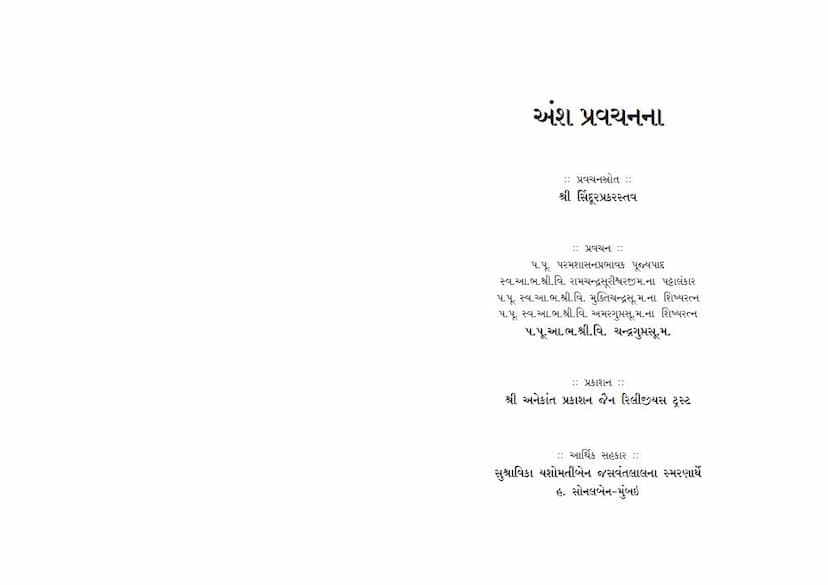Sindur Prakar Stava Vachna
Added to library: September 2, 2025

Summary
This Jain text, Sindur Prakar Stava Vachna by Chandraguptasuri, published by Anekant Prakashan Jain Religious, is a discourse on the path to liberation (moksha) within Jainism. The text emphasizes the interconnectedness of knowledge (gyan), self-control (sanyam), and austerity (tap) as the fundamental pillars for spiritual progress.
The discourse, primarily delivered through lectures, focuses on the importance of Upadhan Tap, a rigorous spiritual practice undertaken by householders as a significant path to spiritual advancement. It highlights that while Upadhan Tap enforces austerity and self-control, dedicating time for acquiring knowledge is crucial for true spiritual growth.
Key Themes and Teachings:
-
The Trifecta of Moksha: The core message revolves around the necessity of integrating knowledge, self-control, and austerity.
- Knowledge (Gyan): Essential for understanding the right path, dispelling ignorance, and purifying oneself from karmic obstructions (gyanavaraniya and darshanavaraniya karma).
- Self-Control (Sanyam): Crucial for preventing the influx of new karma (ashrav) and controlling desires and passions.
- Austerity (Tap): Necessary for shedding past karma (nirjara) and purifying the soul.
-
The Importance of a Guru's Guidance: The text repeatedly stresses the need for a Guru's guidance, even when practicing austerities or studying scriptures. The Guru provides the correct understanding of the scriptures, helps in overcoming ignorance, and guides the disciple on the true path to moksha.
-
Discernment in Devotion: The text outlines four types of devotion (bhakti) as essential for liberation:
- Devotion to Tirthankaras: The first and foremost. It's explained that Tirthankaras show the path to overcoming suffering and achieving liberation.
- Devotion to Gurus: Essential for removing ignorance and gaining authentic scriptural knowledge.
- Devotion to Jinmat (Jain Principles/Philosophy): Emphasizes adhering to the Lord's teachings rather than personal interpretations or desires.
- Devotion to Sangha (Community of Jain Monastics and Followers): A community that strives for spiritual progress together.
-
The Nature of True Dharma:
- Renunciation of Worldly Desires: The text strongly advocates for detachment from worldly pleasures and desires (vishaya-sukha-trushna). It asserts that true dharma is not about accumulating merit but about shedding karma and achieving liberation.
- Understanding Suffering: The discourse highlights that suffering arises not just from external hardship but also from the attachment to worldly pleasures and the aversion to difficulties. True dharma involves embracing difficulties for spiritual growth and letting go of the pursuit of pleasure.
- The Dangers of Attachment: It warns against attachment to worldly possessions, relationships, and even the results of good deeds if they are done with an expectation of worldly happiness.
-
The Fruits of Devotion and Dharma: The text elaborates on the numerous benefits of devotion and practicing dharma, including:
- Removal of sins and negative karma.
- Protection from lower realms of existence (durgati).
- Overcoming obstacles and calamities.
- Accumulation of auspicious karma (punyanubandhi punya) that leads to favorable circumstances for spiritual practice, including the necessary conditions for taking diksha (monkhood).
- Cultivating inner qualities like knowledge, good health, favorable circumstances, reputation, and ultimately, achieving spiritual bliss and moksha.
-
The Virtues to Cultivate: The text emphasizes the cultivation of various virtues for spiritual progress, including:
- Non-violence (Ahimsa): The paramount virtue, extending to avoiding harm to all living beings through thoughts, words, and deeds.
- Truthfulness (Satya): Speaking truthfully and avoiding all forms of falsehood.
- Non-stealing (Aparigraha): Not taking what is not rightfully given.
- Celibacy (Brahmacharya): Abstinence from sensual pleasures.
- Non-possession (Aparigraha): Limiting material possessions.
- Control of the Senses (Indriya Dam): Subduing the five senses.
- Patience and Forbearance (Kshama): Tolerating unpleasant speech or actions.
- Humility (Vinaya): Respect for elders, gurus, and scriptures.
- Generosity (Dan): Giving to worthy recipients.
- Austerity (Tap): Self-discipline and mortification of the flesh.
- Devotion and Contemplation (Bhavana): Cultivating inner purity and mindfulness.
- Detachment (Vairagya): Developing indifference towards worldly pleasures and pains.
- Good Conduct (Soujanya): Acting with kindness, speaking well of others, and avoiding backbiting.
- Association with the Virtuous (Gunisangam): Seeking the company of those who are spiritually inclined.
-
Overcoming the Inner Foes: The text identifies internal enemies like anger (krodh), pride (man), deceit (maya), and greed (lobh) as major obstacles to liberation and urges the reader to conquer them through self-awareness and disciplined practice.
-
The True Meaning of Dharma: The discourse challenges superficial religious practices, emphasizing that true dharma lies in the intent and inner transformation rather than mere outward rituals. It stresses the importance of purifying one's motivations and focusing on the ultimate goal of liberation.
In essence, Sindur Prakar Stava Vachna serves as a profound guide for spiritual seekers, offering a detailed roadmap to achieve moksha by emphasizing the practice of Upadhan Tap under the guidance of a Guru, cultivating essential virtues, conquering inner passions, and ultimately, dedicating one's life to the path shown by the Tirthankaras.